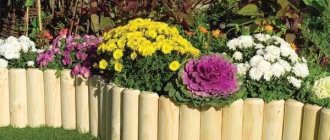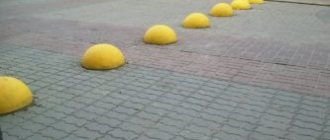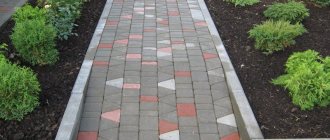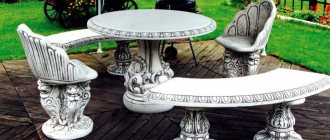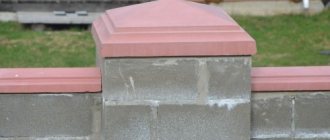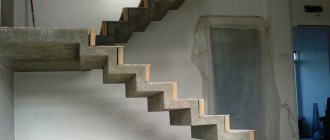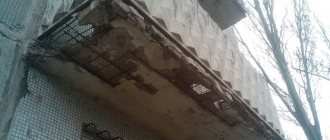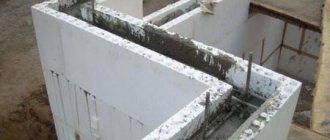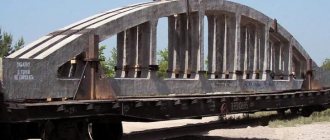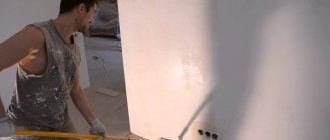Concrete flower beds are the most common product designed to decorate a plot of land with flowers. The choice of material for creating flower beds is determined depending on the characteristics of the soil and the nuances of landscape design. For example, a flowerbed made of wood needs reliable protection from possible rotting. At the same time, plastic is not suitable for use on inclined surfaces, as it may crack when the soil moves. Brick is not often used to make flower bed shapes with a small radius. In most cases, installing a concrete structure is considered the best option. This building material is recognized as one of the most durable, which is why builders most often resort to the manufacture of concrete products.
Concrete flower beds: nuances of technology and methods of decoration
Concrete flower beds help to decorate a garden plot, design a local area, limit and set the direction of movement, and simply landscape the area.
The variety of shapes and possible finishing solutions allows you to use outdoor concrete vases on any surface with an even surface. A concrete planter will fit well into the landscape of a green lawn, will look great on paving stones, paving slabs and will decorate an ordinary asphalt path. How to make a flowerpot on your own, and what nuances need to be taken into account, we will consider in this article.
Possibilities for arranging flower beds
Conventionally, all flower pots can be divided according to functionality and area of placement.
Flowerpots are:
A variety of materials can be used to make any flower pot, some of which can be used in all three types.
Discussing the creation of a yard flowerbed, we will determine that for an outdoor flowerpot the following can be used:
Of course, any of these materials has its advantages and disadvantages. What kind of flower beds to decorate the yard with is decided by each owner independently, based on financial capabilities and the territory development project.
We will focus on a flower bed made of concrete, since it is actually a universal material that can fit into any style and take any shape.
Advantages of concrete flower beds
What is the difference between a concrete flower bed and flower beds made of other materials?
Concrete mortar is a very pliable material when forming a product, and at the same time the finished structure has great strength. Concrete planters can be used outdoors without fear, because properly processed concrete is not afraid of temperature changes and moisture.
The advantages of concrete compositions also include:
- A concrete flower bed can be used as a stable barrier that limits the passage area, while the flower bed does not block the view, maintaining spatial unity.
- Concrete flowerpots have a high mass, so they can become a vandal-proof barrier that is very difficult to steal.
- Vertical concrete compositions will save yard space in case of shortage, while creating a green area.
- A properly made concrete flower bed retains its shape and aesthetics for a long time.
On a note! Outdoor concrete flower beds are budget products. The cost of a finished flowerpot is essentially equal to the cost of sand and cement spent on their production.
Some disadvantages
When making a flower bed using concrete mortar, it is necessary to use various additives to improve the properties of the material. This slightly increases the cost of finished products.
There are also very definite disadvantages to these flower beds:
- The large mass makes the flower beds stationary. Rearranging them will require significant physical effort.
- The look of untreated concrete will not fit anywhere. Concrete flower beds require decorative treatment.
- Even a small concrete pot looks very massive and visually “eats up” the space.
Flowerbed made of concrete
Cement is a fairly economical material, and due to the plasticity of the concrete solution, any shape can be created from it. But by itself, concrete has a very unsightly gray color, and if you are not planning to create a yard in the style of post-apocalyptic urbanization, then it is better to use paints when mixing the solution.
Important nuances
It is the shape and color of the future vase that you should pay attention to. The appearance of the flowerbed should not compete with the flowers planted in it.
For this reason:
- When finishing concrete pots, you should use soft shades of colors.
- Painted pots in their ornament can combine the colors of the plants planned to be planted in them.
- If the flower bed in the flower bed is planned to change depending on the season, neutral colors should be used when decorating.
On a note! Consider the installation space of the flower bed. A large wide vase in a small area will add inconvenience, and small pots on a wide terrace can become visually lost.
In addition to the color palette, you should consider some of the physical features of the pot. Water should not stagnate inside the pots - this will have a detrimental effect on both the plants and the concrete walls of the vase.
To do this, it is necessary to make technical holes in the bottom of the flowerpot to drain water. They can be laid at the stage of pouring the mold, if the concrete vase is made by hand, or drilled into a ready-made product.
Another disadvantage of concrete is its high porosity. A pot made of sand and cement will not last long.
In order for outdoor concrete flower pots to bring joy for many years, water-repellent and frost-resistant additives should be used when mixing the solution. Detailed instructions for using such additives are always written on the original packaging.
Materials for the solution
If you decide to create a concrete masterpiece yourself, then you need to prepare the material for the vase and the tools and materials for the formwork in advance. The solution for a concrete flower bed is mixed in a standard proportion: 1 part cement to 3 parts sifted fine sand. In addition, you should stock up on dye.
In a concrete vase painted in the mass, the following can be used as a dye:
Experts determine what to pay attention to
Advantages of concrete flower beds
| Options | Characteristic |
| Durability | Resistance to mechanical stress |
| Moisture resistance | |
| Simplicity | Possibility of manufacturing products with different configurations |
| Plastic | Concrete flower beds are made in the form of planting elements |
| Decorativeness | Possibility of giving the surfaces of flower products different structures |
| Heavyness | Allows the use of concrete flower beds as an anti-vandal element |
| Sustainability | You can make a separation barrier between sectors of the estate |
| Verticality of the form | Makes it possible to optimize placement in the yard |
Flaws
The dimensions and weight of concrete flower products do not allow them to be moved freely on the site.
The negative qualities of products for flower beds include:
- Relative stationarity. The weight does not allow free movement around the estate.
- Additional processing is needed. A “raw” surface has an unaesthetic appearance, so it must be additionally decorated.
- Massive shape of the product. The solidity of the flowerpot visually “absorbs” the space of the yard.
- Additional additives for concrete. It is necessary to improve the properties of the material.
When it is possible to make such a product yourself, the cost will be low - it will only include the cost of cement and sand used for its manufacture.
DIY concrete flowerbed
Concrete flower beds are the most common product designed to decorate a plot of land with flowers. The choice of material for creating flower beds is determined depending on the characteristics of the soil and the nuances of landscape design. For example, a flowerbed made of wood needs reliable protection from possible rotting. At the same time, plastic is not suitable for use on inclined surfaces, as it may crack when the soil moves. Brick is not often used to make flower bed shapes with a small radius. In most cases, installing a concrete structure is considered the best option. This building material is recognized as one of the most durable, which is why builders most often resort to the manufacture of concrete products.
Purpose
The flowerbed is used to decorate flower beds. Concrete flower beds for planting flowers decorate parks, squares, gardens and other areas. At the same time, it is important that the products fit harmoniously into the landscape design and environment.
Features of concrete flower beds
A concrete flowerbed has a number of features, one of them is the creation of a shape that contrasts with the lawn. The flowerbed can be given a place in the central part of the land, near the fountain or in the back of the yard. Concrete flower beds and flower beds come in different shapes: they are made rectangular, semicircular, square, etc.
Products can have either a multi-colored or a single-color surface. Experts advise planting several types of plants and flowers in a concrete form. They should be combined in shades and height. In the middle of the concrete product, the seeds are planted more freely, and at the edges - more densely. For example, you can plant marigolds and border them with low plants. The form in which one type of flower is planted also looks good.
Examples of products and manufacturing technology
Before making flower beds, you need to prepare a plan for the product or its borders. When it is ready, you can proceed to making the mold. First, you will need to purchase building materials from a specialized store. To make a flower bed, you need to mix a concrete solution. The ingredients used are water, cement mixture, sand, and crushed stone. In addition, during work, builders use an ordinary shovel.
Concrete flowerpots: forms. Concrete flower beds and flower beds
Attractive landscape design makes the house stand out from the rest and pleases the eyes of its owners for a long time. There are many different options and methods for arranging a site. Flowerbeds and flowerpots made of concrete are quite common.
Advantages and disadvantages
The original concrete elements are designed to complement the overall exterior. They maintain soil temperature and retain moisture, and the materials for their manufacture are low cost. Such structures are used both in personal areas and in city parks and squares. They are versatile, can delimit a site into separate zones and act as landscaping elements. Flowerpots for the garden attract attention and decorate the area; they are presented in a wide range in specialized stores. You can also make them yourself if you wish; this does not require special skills or tools. The main disadvantage is the significant weight, which makes it difficult to move the products.
Properties
Concrete flower beds add coziness and originality not only to parks and embankments, but also to the adjacent area. A wide variety of types opens up extensive opportunities for the implementation of design ideas. They also highlight the plants planted in them and eliminate the need for planting them. The importance of this function should not be underestimated, since thanks to this the root system of the flowers is not damaged.
One of the reasons for the popularity of products is mobility. In case of prolonged rainfalls and frosts, to preserve the plants, they need to be moved to a more suitable place. This is especially true for delicate, expensive species, since most of them do not tolerate excessive watering and freezing temperatures.
Concrete flower beds can be finished with various materials, for example, ceramics. Choosing the appropriate design option will allow you to decorate not only the elements themselves, but also the entire landscape. The products are low in cost, which is an additional reason to purchase them. Materials for self-creation will cost a small amount.
It is worth noting the high resistance to temperature changes; on average, structures can withstand about 200 freezing phases without loss of quality. The appearance remains the same even with the constant influence of surrounding negative factors and ultraviolet radiation, which plastic products cannot boast of.
One of the advantages of making it yourself is the practicality of concrete: before it hardens, it can be created into a wide variety of shapes and forms. In addition to their decorative purpose, garden flowerpots perform excellent enclosing functions. They allow you to separate the necessary territory or delimit a site. To do this, it is enough to purchase several structural elements. This way you can not only complement the space with bright floral accents, but also prevent vehicles from entering the territory in the absence of a fence.
Types
The modern assortment is represented by various options suitable for specific purposes:
- Decorative flowerpots made of concrete, in addition to park areas, are used in small areas where it is important to preserve as much free space as possible, in which case compact flower beds are selected.
- Outdoor ones can have different sizes and designs.
- Indoor ones are divided into standard and portable types. The shape depends on the surrounding interior and has no restrictions.
What to consider
First of all, garden flowerpots should be in harmony with the surrounding space. A combination of several different shapes, strict geometric or neat rounded, is possible. Large structures look best over large areas, but are rarely suitable for small areas.
Particular attention is paid to the color scheme. It is worth noting that the shade of the product should be less bright and intense compared to the plants flowering in it. The best option is plain elements that match the decoration of the house or fence.
Execution options
The molds for concrete flowerpots used for production have a significant impact on the external characteristics and quality. The composition for pouring is prepared in advance and placed in the blanks. In addition to hardening the mass, time is also given to gain the necessary strength. The walls of the mold are lubricated with an oil solution, which, as a rule, is based on ordinary vegetable oil. This reduces the adhesion of concrete, and it moves away better from the surface of the form, which is especially important for complex designs with additional protrusions and elements.
Polyvinyl chloride has become most widespread as a material for the production of molds, since its characteristics open up wide possibilities for choosing a relief and pattern for the resulting structures. Plaster, plastic and silicone are also used.
DIY concrete flowerpots
Sometimes it is not possible to find suitable design options or they are unaffordable, in which case the solution to the situation is to create flower beds yourself. The technology is simple and will not cause difficulties even for those who have never worked with concrete. One of the advantages of hand-made elements is the lower total cost compared to store-bought options.
Before starting work, you need to prepare the following:
- spray;
- oil;
- water;
- cement composition;
- containers of sufficient volume.
Manufacturing process
To begin with, a suitable container is selected that allows you to form garden flowerpots of the required size. Obtaining the desired result depends on compliance with all stages of manufacturing.
First of all, the outer part of the small vessel and the inner surface of the large container are lubricated with oil. The drainage is a plastic pipe, cut into 4 parts with a length of at least 5 cm.
If colored flowerpots made of concrete are needed, then suitable dyes are added during the preparation of the solution. Particular attention is paid to the correct proportional ratio of sand, cement and water, which is indicated on the packaging.
The first stage of creating a product is filling a large container with a cement composition. The layer thickness should not exceed 2-3 cm.
Next, the plastic pieces are fixed and left until the solution sets. Now a small container is placed in the container, it is important that the tubes are covered with cement. The resulting free space is filled with the solution.
The cement will completely harden in about a day; it may take longer depending on the surrounding temperature conditions and the type of material. Now a small form is pulled out, and the walls are treated with water using a spray bottle. Large containers must be left for 7-10 days, pre-wrapped in polyethylene and moistened with water daily.
After the specified time has passed, the concrete flower beds are removed from the mold. Now you can use the product and plant the desired plant in it.
Material characteristics
Concrete is the optimal material for forming garden structures. It is not susceptible to negative environmental influences, rotting and is characterized by high plasticity, allowing the creation of a variety of complex shapes. Despite such positive characteristics, there is also a drawback, which is rapid heating under the sun's rays. As a result, overheating of the soil and damage to plants is possible. To solve this problem, two methods are used: creating many holes at the bottom of the product, or outdoor concrete flowerpots are made in the form of large structures, which will reduce their overall heating.
fb.ru
Brick, wood, cement and flowers - that's all you need to make your garden unique
It may be a banality to compare a blooming flower bed with a scattering of precious stones, but I would like to call a worthy frame for a flower garden a frame. A flowerbed laid out on the dug-up surface of a plot without clear boundaries will obviously lose out to a flower garden with a clearly defined shape. You can frame a flower bed using various materials.
Decorating flower beds using wood
The frequent choice of wood raw materials for making flower beds is explained simply:
- inexpensive environmentally friendly material,
- easy to process with your own hands, even with little experience,
- usually available in abundance on a site where construction work has recently been completed,
- It is not difficult to repair and reconstruct the created structures.
Wood, as a building material for flower beds, has, at the same time, a number of disadvantages. The main one is fragility. Under the influence of precipitation and contact with the ground, wood begins to deteriorate.
With high-quality treatment, a wooden flower bed can last 5-10 years
Before you begin assembling wooden structures for arranging a flower bed, you must carefully treat all parts with special antiseptics. In addition to store-bought products, to extend the life of a flower garden, you can impregnate all wooden elements with oil, drying oil, and coat them with varnish for exterior use.
Ants love wood that has just begun to rot. They begin to build their homes along the wooden sides of the flowerbed, damaging the flowers and destroying the structure. To combat them, the drugs Grom-2, Anteater and others are used. Slugs like to hide in places where the tree comes into contact with the ground, so in damp areas it is better to make flower beds from a different material.
Despite these disadvantages, many gardeners prefer to make flower beds from wood with their own hands, not trusting the various plastic construction kits sold in garden centers. Many people are afraid of the presence of harmful substances in plastic, its low strength in relation to frost and ultraviolet radiation.
The traditional framing of a flower garden is a palisade of small logs or stakes installed vertically in the form of a dense wall. Such structures are especially effective if they are used to terrace an area with a slope. In this case, the picket fence not only encloses the flowerbed, but also acts as a retaining wall.
The bark from the logs must be removed, no matter how decorative it is - pests settle under it and rot develops.
Cuttings of thick logs or timber left over from the construction of a house will be used to make a flower garden in a rustic style. They are placed in the intended place after protective treatment in the form of a chopped crown. The internal space is filled with nutritious soil and flowers are planted.
Ready-made concrete forms for flower beds
Such products can be placed on the surface of the earth or buried in the ground. Ready-made concrete forms are not protected from moisture like flowerpots. For this reason, they need to be protected from soil that contains a lot of water.
Concrete blocks
Such products are distinguished by smooth lines, durability, and medium size. The main use of concrete blocks is the construction of load-bearing dry masonry walls. The design of some types provides holes for the rods. With their help, it is easy to make a structure that will act as a flower bed. The blocks are hollow, so soil is poured inside and seeds are planted. They can be installed in multi-level structures - this is how a complex flower garden is formed.
Concrete pipes
They are installed vertically. Products are used to delimit the area, since different crops, trees and shrubs are planted in each pipe. If desired, entire combinations of plants can be created. The pipes are buried at different levels, which allows you to create unusual flower beds from concrete.
Homemade concrete flower beds - non-standard landscape design ideas
Cement, sand, crushed stone, water and a little imagination - that’s all you need to create a beautiful flower garden in your country house. Every summer resident can become a constructor and designer of unique creations. Homemade concrete flower beds are an excellent opportunity to put into practice your ideas for creating non-standard flowerpots, vases, pots and other original containers for decorating the garden landscape. Shape, design, size - everything is in the power of the master, all that remains is to roll up your sleeves and start creating.
Ideas for creating concrete flower stands
Concrete has one undeniable advantage over other materials - it does not limit imagination and allows the master to create concrete flower beds of the most bizarre and unusual configurations with his own hands. These can be huge free-standing stationary structures, portable flowerpots of different sizes, and small pots.
The shapes of concrete flower beds are also varied: square, polygonal, oval, round, cone-shaped, as well as the depth and external design of the product. A creative person always has the opportunity to decorate his plot with original flower beds, the ideas of which were born in his head.
How to make a stationary flower bed
If you decide to make a stationary concrete flower garden with your own hands, then first select a suitable place for it. Please note that the structure will be there permanently, it cannot be moved or moved, so choose an area for which you will not have other plans in the future.
How to mark a place for a flower garden
If you have already decided on the shape and size of the future flower bed, draw its outer contours on the ground. Then set aside 15–20 cm from them towards the center and draw another line, it will serve as the internal border of the structure. This way you have indicated the width of the wall of the flower bed. In order for a concrete flower bed to be stable and durable, the wall thickness should not be less than 15 cm.
Along the outlined area, dig a groove 10–15 cm deep, but do not throw earth inside, as it will interfere with your further work. Compact the bottom and sides of the trench well.
How to make a frame for a future structure
To make a concrete flowerbed with smooth and regular walls with your own hands, you need to install formwork on both sides of the dug trench. It is usually made from fiberboard or chipboard sheets. If you want a beautiful wavy shape for your concrete flower bed, use wavy plastic instead of plywood or wood board.
Drive wooden blocks into the ground along the perimeter of the ditch, then nail sheets of plywood to them, simultaneously bending them to fit the outline. To secure the structure from the outside, install spacers. You can secure the formwork using metal tubes, which are installed on the outside of the sheets and connected to each other with thick wire, as shown in the photo below.
How to prepare and pour concrete
How to make a concrete flowerbed strong, reliable and stable? To a large extent, this depends on the solution intended for pouring. It must be prepared in compliance with the required proportions. For a bucket of cement you need to take three buckets of sand, a bucket of crushed stone and water.
Decorating a flower bed
By creating concrete flowerpots for the street, you can make not just a vase, but a real decoration of your yard area. At the same time, you can decorate both a mold you made yourself and a purchased flowerpot. We will describe some possible design options for a flower bed and illustrate them with photos for clarity.
Coloring
The easiest way to decorate a vase is to paint the concrete surface. For this you should use paints for concrete and stone for exterior use.
Before applying paint, the surface of the flower bed should be treated at least twice with a deep penetration primer. The coloring is remarkable in that it can be changed depending on the plants planned for breeding.
Bas-relief
You can decorate a flowerbed using a bas-relief. To obtain an interesting pattern on the surface of the vase, you can use burdocks or other plants with large, hard veins on the leaves.
The leaves should be fixed on the inside of the outer part of the formwork, and then the solution should be poured. After the formwork panels are removed, the leaves can be removed with plain water.
On a note! You can enhance the effect of the openwork foliage pattern by highlighting the veins with colored tinting.
Mosaic
Concrete flower beds can be decorated with mosaic patterns. Quick-drying construction adhesive is suitable for securing mosaic elements.
You can use shells or sea pebbles brought from vacation as parts of the panel. Parts of broken tiles and any materials that are not exposed to water are perfect.
Stages of mosaic application:
- First, draw on paper what you want to depict on the vase. In this case, it is necessary to take into account the direction of the surface of the bowl. This is especially important if the mosaic is glued to a spherical flower bed.
- On the surface of the finished bowl, use chalk to mark the boundaries of the design you plan to make.
- First, the borders of the depicted elements are glued, then the voids are filled. The technique is reminiscent of a children's coloring book.
- After the entire pattern has been laid out, the surface must be opened with varnish.
Concrete flower stands - practicality and durability
Many people consider flower beds and flower beds to be one of the main elements in landscape design. The general perception of the territory often depends on their appearance and characteristics. Today they are made from a variety of materials, but concrete flower beds and flower beds are considered the most practical and reliable.
In the photo - a concrete flowerbed in the garden
Product characteristics and features
The number of types of flower beds for shrubs is very large, including “live” ones made from ground-blooded roses or other plant varieties. But concrete flower beds are considered the most functional products that have many advantages and attractive features.
Concrete flower beds in landscape design
Positive and negative qualities
- Concrete products are not destroyed for decades from climatic and natural factors.
- They retain aesthetic appeal for a long time.
- Due to their massiveness, flower beds become a serious problem in the face of acts of vandalism. In addition, it is unlikely that anyone will decide to steal them due to the large weight of the product.
- Concrete flower beds make it possible to intelligently divide the territory into the required areas.
- Flowerbeds are well suited for organizing vertical gardening in the garden.
Flower bowls made of concrete for streets
In addition to the positive qualities, concrete street flower stands also have disadvantages that must be studied first. Thanks to this knowledge, you will have a chance to make the right choice of material for your flower garden.
Gray concrete flower girl Ts 25
Advice: immediately select a place for the flowerbed, since due to its heavy weight, moving it to another area will be very problematic.
You should also know that such flower beds are not universal and may not always fit into the style of the garden. Therefore, before you start making them, make sure that they will look natural in it.
The next feature of a flower garden is that visually they can often look bulky. In this case, they should be installed on the site carefully, otherwise the flower beds will overshadow other design elements of the territory.
Rectangular forms for concrete flower beds
How to make flower beds from concrete yourself
The price of making a concrete flower bed yourself will be much lower than purchasing one. Before you start creating it, outline the boundaries of the future structure on the site. Pre-prepare the area by removing all debris.
Materials you will need:
- sand, preferably sifted river sand,
- cement (fresh),
- pure water,
- fine crushed stone,
- shovel.
Below are instructions for the process:
- In this case, you can take wavy plastic or small planks, then the shape of the flower bed will be more interesting.
- Cut the plastic in half, choosing the direction “along the wave”, so you will not disturb the structure.
- Dig a trench up to 150 mm deep along the outlined contours.
- Make the width of the ditch equal to the width of the walls of the structure being manufactured, taking into account the thickness of the formwork.
- Install strips of cut plastic around the perimeter, bending them to the shape of the future flower bed.
- Secure it on the outside with pegs.
- Use a concrete mixer to prepare the mixture. This will save you time and effort, but if you don’t have such equipment, use a solution container and a shovel.
- Maintain proportions:
- 1 bucket of cement,
- 3 buckets of sand,
- 1 bucket of crushed stone,
- 10 liters of water.
- Add the liquid carefully, as the solution should have the consistency of “liquid sour cream.”
- Stir the mixture several times, being careful not to form lumps.
- pour the concrete mixture into the mold,
- cover it with film from precipitation,
- wait about 3 days until the solution first hardens,
- remove the formwork and clean up its contours.
In addition to plastic, wood is often used for formwork, the price of which is quite affordable for everyone, and you can also use used material. Just make sure that it was smooth and without flaws, and even a person far from such work can handle its construction.
Original concrete flower garden on the site
- boards or sheets of plywood,
- bars for supports,
- nails or screws.
Drive the supports into the ground, then attach plywood sheets to them, attaching them from the inside of the structure. Also use external side spacers to make the formwork for the concrete product strong. The distance between them is approximately 300 mm.
In this simple way, you can make a concrete flower bed with your own hands on your site. This will make it possible not only to create an original design, but also to add variety to the landscape design of the garden. The flowerbed can become one of the main accents, and it will also be assigned practical functions.
Concrete trees
In recent years, new elements have appeared among the small architectural forms (small architectural forms) installed in public parks and recreation areas - artificial trees made of concrete. Such compositions are used to decorate the space of territories, focusing attention on certain zones.
Trees are made from sculpted concrete. Today they have become an integral part of rock compositions, grottoes, suspension bridges and intricate benches. Often, a concrete tree forms the entrance to a summer cafe in a park or a children's playground. With the help of such sculptures you can create a unique, fabulous, magical world.
It is noteworthy that manufacturers make such plants hollow, which means they can be used as additional storage space. Decorative concrete can be used to make both a whole tree and its individual parts: stumps, rhizomes, branches - vines.
Features of concrete flower beds
Concrete flower beds are used almost everywhere; there are no restrictions on their use. They are made from high-strength materials and placed on objects for various purposes. Here it is important to be able to choose the right design solution so that the concrete structure has the most advantageous appearance and is an additional decorative element.
Outdoor concrete flower beds are presented in a wide variety of variations; they can differ in both shape and size. They are used as a kind of space delimiter, to create an accent against the background of a green carpet - lawn, flower crops. Concrete flower beds are also chosen for landscaping because they can be painted multiple times. Their surface can be either smooth or embossed. Installation of a cement flower bed can be done in several ways:
- To the surface. Due to its serious weight, a concrete flower bed is able to occupy a strong position even without additional supports or fastenings.
- By digging into the ground. Thanks to this technique, you can create an original multi-level flowerbed, or adjust its dimensions to the required size.
- By means of formwork equipment in the ground. This design can have high sides or go completely into the ground, allowing you to build diverse flower beds. Cement mortar is poured into this formwork and, after drying, painted if necessary. Ornamental crops in this case can also be of different sizes and in different quantities. As an option, you can make a flowerbed in the form of a specific design or pattern.
Advantages
Among the positive characteristics of concrete flower beds are:
- high degree of resistance to negative environmental factors (excessive humidity, precipitation);
- excellent strength qualities;
- long service life (almost 50 years);
- high aesthetic qualities;
- saving yard space when using vertical concrete compositions;
- use as a sustainable barrier;
- the possibility of creating multi-level flower beds;
- easy to paint;
- possibility of making it yourself;
- ease of care.
Flaws
The disadvantages of cement flower beds include:
- large size;
- large mass;
- the need for decorative processing;
- difficulty in moving to another place.
If there is a need to make an elegant flower garden, then instead of cement it is recommended to use more suitable materials, for example, gypsum.
Forms for pouring concrete flower beds
To make a round flowerbed from concrete or any other shape, you can use ready-made molds or make them yourself.
Purchased forms
Molds made of plastic and silicone are available for sale; they are easy to use and have a wide range. To make a concrete flower bed, it is enough to assemble a mold, lubricate it with oil for easier removal of the product, and fill it with cement mortar. After two days, the concrete mass should harden and the form can be removed. But given the high cost of such products, it is more advisable to purchase them if not one, but a large number of flowerpots are made.
Forms from improvised means
This solution is budget-friendly; any plastic container can be used to make flower beds. They are also lubricated inside with oil, a bucket of stones is placed in the center for better stability, and the space around it is filled with concrete. The cement mortar hardens after 48 hours, after which both the bucket and the mold are removed. You can decorate a concrete flowerbed with mosaics, paint it in a suitable color, or leave it as is.
You can also make flower beds with your own hands from fabric and cement. The manufacturing process is quite simple: the fabric is immersed in concrete for impregnation and then hung on a bucket. A flowerbed made of cement and rags can have a more original look if the edges are slightly bent when the mortar begins to set. If you use burlap as a fabric for a concrete flower bed, you can achieve an interesting topography.
Photos of a flower bed made of cement and fabric are presented below.
